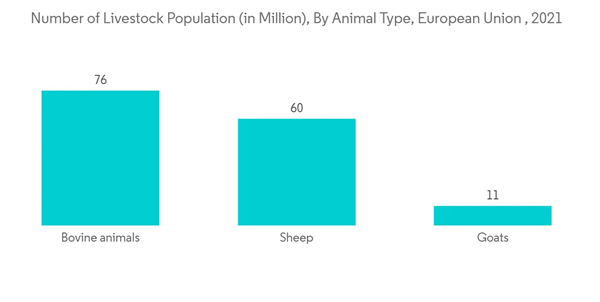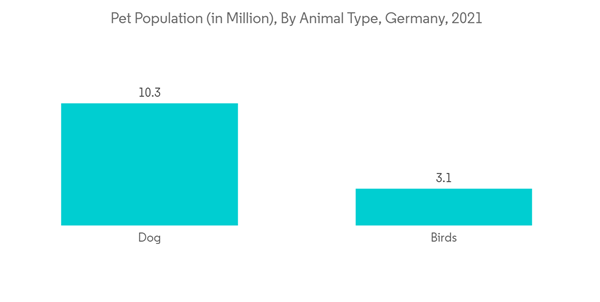The emergence of COVID-19 had an impact on the Europe veterinary vaccine market during the initial pandemic days due to the strict lockdown restrictions imposed by the government to curb the spread of COVID-19, which led to a decline in the demand for veterinary vaccines in Europe. However, the market is recovering since the lockdown restrictions were lifted in the European region, and as the cases of COVID-19 are on the decline and the demand for veterinary vaccines in Europe is increasing, thus fueling the growth of the market over the forecast period.
The key factors propelling the growth of this market are increasing incidences of livestock diseases, initiatives by various government agencies and animal associations, and key market players' strategies in the European region. For instance, according to an NCBI article published in November 2021, the incidence of Cryptosporidium, which affects cows, was 25.7% in Belgium, 24.9% in France, and 20.8% in the Netherlands. The report also mentioned that, overall, 93% of the farms in Western Europe were Cryptosporidium positive. Such a high incidence of livestock diseases is expected to be one of the crucial driving factors for the growth of the market over the forecast period.
In addition, per the Government of United Kingdom data in May 2022, nearly 1,832 African swine fever cases were recorded in Europe among domestic pigs. Such a burden of infectious diseases among animals across the European region is expected to increase the demand for veterinary vaccines, thereby contributing to the growth of the market during the forecast period. Also, the increasing product developments by the market players in Europe are expected to contribute to the market's growth during the forecast period. For instance, In September 2021, Boehringer Ingelheim received a positive opinion from the European Union for the combined use of Ingelvac CircoFLEX and Ingelvac PRRSFLEX EU for pig health management. The combined administration of both vaccines represents innovation in pig health management.
Likewise, the large size of the livestock and cattle population in the European region is also expected to contribute to the growing demand for veterinary vaccines, thereby fueling market growth. For instance, in the data published by Eurostat in May 2022, the European Union had approximately 289 million livestock animals in December 2021. Thus, the factors mentioned above, such as the growing prevalence of zoonotic diseases, the large size of the veterinary population, and increasing product launches, are expected to drive the growth of the studied segment during the forecast period. However, high storage costs for vaccines and lack of veterinarians, and a shortage of skilled farmers are expected to restrain the growth of the market over the forecast period.
Europe Veterinary Vaccine Market Trends
Live Attenuated Vaccines Segment is Expected to hold the Largest Market Share Over the Forecast Period
The live attenuated vaccines segment in the European veterinary vaccine market is projected to grow at a faster rate during the forecast period owing to rising demand for live attenuated vaccines for the effective management of veterinary diseases. Live/attenuated vaccines contain a weakened version of the living microbe, making it ineffective in causing diseases. The live attenuated vaccines produce a similar yet weakened reaction as compared to that natural infections, which makes them more effective than the other types of veterinary vaccines. The efficacy of the live attenuated vaccines, such as strong cellular and antibody responses that often confer lifelong immunity with only one or two doses, is expected to drive the growth of the studied segment over the forecast period.The efficacy of the live attenuated vaccine over the conventional vaccines is also expected to boost the growth of the studied segment. For instance, the MSD Manual data published in 2021 mentioned that the use of live organisms in veterinary vaccines is more effective than inactivated vaccines in triggering cell-mediated immune responses.
These vaccines must be stored and handled properly, with strict attention to temperature, even in the lyophilized (free-dried) state. After the reconstitution, the dose of the vaccine should be administered promptly (within 1 hour) or discarded. Some examples of these types of vaccines include canine distemper virus vaccines and all canine parvovirus and adenovirus-2 vaccines. For instance, in August 2021, EMA published that Nobivac DP plus is a live attenuated veterinary vaccine that can be used to protect dogs against two separate infections caused by canine distemper virus and canine parvovirus. Such availability of live attenuated vaccines authorized by government organizations is expected to contribute to the growth of the studied segment. Owing to the rising use of live attenuated vaccines, the segment is contributing to the largest market share of the European veterinary vaccine market.
Germany is Expected to Hold Notable Share in the Market Over the Forecast Period
Germany is expected to hold a significant share of the Europe veterinary vaccine market during the forecast period.The factors attributing to the growth of the market in Germany are increasing zoonotic diseases and key market players' activities. For instance, in January 2021, Boehringer Ingelheim introduced the VAXXITEK HVT+IBD+ND vaccine, which offers robust immune support and improved defense against Marek's infectious bursal disease (classic and variant kinds), and Newcastle disease.
According to DDH, 2022, 47% of the households in Germany will have pets in 2021. In addition, 34.7 million dogs, cats, small animals, and ornamental birds were kept by the population in the country. As per the same source, the number of cats adopted was higher in Germany as compared to dogs, as 16.7 million cats live in 26% of German households in comparison to 10.3 million dogs in 21% of families, including the number of mixed-breed dogs. Thus, the rising adoption of pets and other companion animals in the country is expected to increase the need for vaccination to prevent them and themselves from developing zoonotic diseases, which is anticipated to propel the market growth over the forecast period.
Likewise, the large livestock and cattle population in Germany is also expected to contribute to the demand for veterinary vaccines, thereby contributing to the market's growth. For instance, in the article published by German Livestock in March 2021, Germany had around 12.9 million head of cattle in total, including 4.2 million dairy cows and 0.7 million suckler cows. The article also mentioned that Germany has the largest dairy cattle herd and the second-largest cattle population in the European Union.
Furthermore, a 2021 German study published in September 2022 reported the incidence of diarrhea to be 18.5% and the most common disease observed in almost 14,000 neonatal calves examined on 731 German dairy herds. As a result, it is projected that these changes will have a beneficial effect on the market, spurring market expansion over the forecast period in Germany.
Europe Veterinary Vaccine Market Competitor Analysis
The European veterinary vaccine market is moderately competitive and consists of a few major players. A few major players currently dominate the market in terms of market share. Companies like Zoetis Inc., Merck & Co. Inc., Virbac, Elanco, and Boehringer Ingelheim International GmbH, hold a substantial market share in the European veterinary vaccine market.Additional benefits of purchasing the report:
- The market estimate (ME) sheet in Excel format
- 3 months of analyst support
This product will be delivered within 2 business days.
Table of Contents
Companies Mentioned (Partial List)
A selection of companies mentioned in this report includes, but is not limited to:
- Merck & Co. Inc.
- Virbac SA
- Hester Biosciences Ltd
- Elanco Animal Health
- Ceva Sante Animale
- Phibro Animal Health Corp.
- HIPRA
- Zoetis Inc.
- Boehringer Ingelheim International GmbH
- Durvet, Inc.










